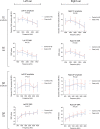Auditory Performance in Recovered SARS-COV-2 Patients
- PMID: 33967243
- PMCID: PMC8115428
- DOI: 10.1097/MAO.0000000000003037
Auditory Performance in Recovered SARS-COV-2 Patients
Abstract
Objective: While COVID-19 symptoms impact rhinology (anosmia) and laryngology (airways), two major disciplines of the otolaryngology armamentarium, the virus has seemed to spare the auditory system. A recent study, however, reported changes in otoacoustic emission (OAE) signals measured in SARS-COV-2 positive patients. We sought to assess the effect of COVID-19 infection on auditory performance in a cohort of recovered SARS-COV-2 patients and controls. To avoid a potential bias of previous audiological dysfunction not related to SARS-COV-2 infection, the study encompasses patients with normal auditory history. We hypothesized that if SARS-COV-2 infection predisposes to hearing loss, we would observe subtle and early audiometric deficits in our cohort in the form of subclinical auditory changes.
Study design: Cross-sectional study.
Setting: Tertiary referral center.
Patients: The Institutional Review Board approved the study and we recruited participants who had been positive for SARS-COV-2 infection, according to an Reverse Transcription Polymerase Chain Reaction (RT-PCR) test on two nasopharyngeal swabs. The patients included in this study were asymptomatic for the SARS-COV-2 infection and were evaluated following recovery, confirmed by repeated swab testing. The control group comprised healthy individuals matched for age and sex, and with a normal auditory and otologic history.
Interventions: The eligibility to participate in this study included a normal audiogram, no previous auditory symptoms, normal otoscopy examination with an intact tympanic membrane, and bilateral tympanometry type A. None of our volunteers reported any new auditory symptoms following SARS-COV-2 infection. Ototacoustic emissions (OAE) and auditory brainstem response (ABR) measurements were used to evaluate the auditory function.
Main outcome measures: OAE and ABR measurements.
Results: We have found no significant differences between recovered asymptomatic SARS-COV-2 patients and controls in any of transitory evoked otoacoustic emission (TEOAE), distortion product otoacoustic emissions (DPOAE), or ABR responses.
Conclusions: There is no cochlear dysfunction represented by ABR, TEOAE, and DPOAE responses in recovered COVID-19 asymptomatic patients. Retrocochlear function was also preserved as evident by the ABR responses. A long-term evaluation of a larger cohort of SARS-COV-2 patients will help to identify a possible contribution of SARS-COV-2 infection to recently published anecdotal auditory symptoms associated with COVID-19.
Copyright © 2020, Otology & Neurotology, Inc.
Conflict of interest statement
The authors disclose no conflicts of interest.
Figures

References
-
- Munster VJ, Koopmans M, van Doremalen N, van Riel D, de Wit E. A novel coronavirus emerging in China - key questions for impact assessment. N Engl J Med 2020; 382:692–694. - PubMed
-
- Vetter P, Vu DL, L’Huillier AG, Schibler M, Kaiser L, Jacquerioz F. Clinical features of covid-19. BMJ 2020; 369:m1470. - PubMed
Publication types
MeSH terms
LinkOut - more resources
Full Text Sources
Medical
Miscellaneous

